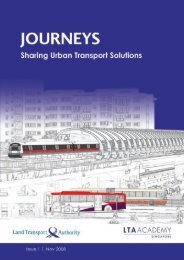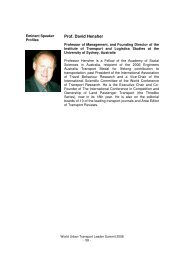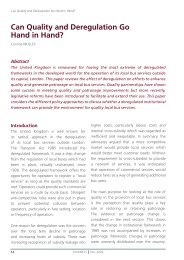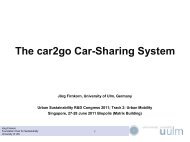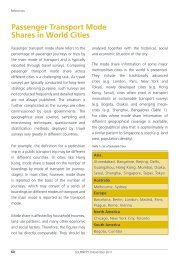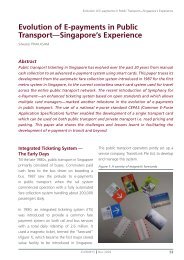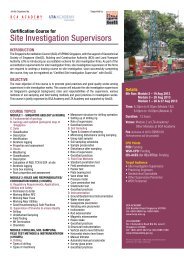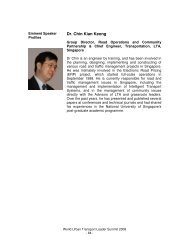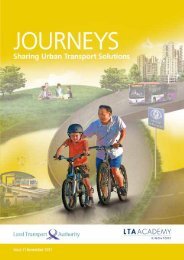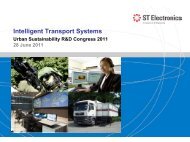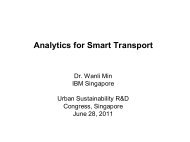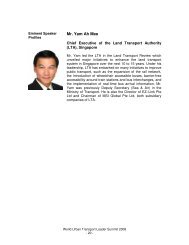Issue 4 May 2010 - LTA Academy
Issue 4 May 2010 - LTA Academy
Issue 4 May 2010 - LTA Academy
Create successful ePaper yourself
Turn your PDF publications into a flip-book with our unique Google optimized e-Paper software.
Proactive National Transport Strategy for Low Carbon and Green Growth in Korea<br />
have been pursued in order to develop green<br />
industries as an ‘engine for growth’ for the<br />
future. As for the institutional framework for<br />
promoting green growth, the National Green<br />
Growth Committee was created in February<br />
2009 and the Green Growth Law is being<br />
deliberated in the National Assembly.<br />
Major developed countries have also<br />
established ambitious national low carbon<br />
green growth strategies. Germany is aiming<br />
at reducing carbon emission by 40% in 2020<br />
compared with 1990 emissions. The U.K.’s<br />
plan is also ambitious: 60% reduction by 2050.<br />
Japan also announced their ‘Thirty Thirty Plan’,<br />
which means 30% GHG reduction by 2030.<br />
Through cutting year 2000’s GHG emissions<br />
by 4.2% in 2006, Japan has already reduced 11<br />
million tons of transport-related GHG. In their<br />
2008 White Paper, the Japanese government<br />
revealed their policy directive involving vehicle<br />
technology and alternative fuel developments,<br />
traffic flow improvement and means to induce<br />
behavioural change in transport users. These<br />
efforts are reflected in Japan’s ultra-efficient<br />
urban transport system and the dominance<br />
of Japanese car manufacturers in the<br />
world markets.<br />
Low carbon green growth is the most urgent<br />
and proactive policy direction for Korea to<br />
maintain its global competitive edge and to<br />
ensure sustainable economic growth. More<br />
specifically, low carbon green growth requires<br />
diminishing GHG emissions and environmental<br />
burdens in the course of economic growth and<br />
simultaneously developing and utilising green<br />
industries for further economic developments.<br />
8<br />
JOURNEYS <strong>May</strong> <strong>2010</strong><br />
New industries are expected to be developed<br />
and subsequently, new markets will also be<br />
created in many energy and environment related<br />
fields as stricter environmental and energy<br />
related regulations are introduced. Korea’s<br />
economy is still centred on manufacturing<br />
and IT, so Korea can leverage its competitive<br />
advantage in these fields to develop GHGreducing<br />
technologies. More attention and<br />
investment should be directed to developing<br />
low carbon green industries in order to drive<br />
momentum for a sustainable future.<br />
Transport in Korea in the Energy-<br />
Climate Era<br />
Mobility has tremendously increased during<br />
the last century. One of the most salient<br />
characteristics of the previous century is<br />
rapid motorisation and expansion of related<br />
infrastructure and industries. Increased vehicle<br />
use has enabled us to enjoy fast and convenient<br />
travel as well as rapid economic development<br />
and economic prosperity. Transport policy in<br />
many countries has centred on the car rather<br />
than on the person. And our lifestyle has been<br />
more and more dependent on automobiles for<br />
our socio-economic activities.<br />
Transport policy in many countries<br />
has centred on the car rather than<br />
on the person. And our lifestyle has<br />
been more and more dependent on<br />
automobiles for our socio-economic<br />
activities.<br />
However, increased automobile use can<br />
cause serious negative repercussions, such<br />
as, air pollution, noise pollution, congestion,



